Corporate and Business Law Assignment: Analysis, Case Study, Review
VerifiedAdded on 2023/01/19
|8
|1823
|51
Homework Assignment
AI Summary
This assignment delves into various aspects of corporate and business law, addressing key concepts such as suffrage, equality (including barriers faced by women and Aboriginal peoples), and immigration policies. It examines the significance of events like the Stonewall riots and legal terms like "access" and "bona fide occupational requirement." The assignment further explores sexual harassment, the application of the Canadian Human Rights Act, and filing procedures in Ontario. A case study analyzes the Indian Act and the Musqueam band's dispute, culminating in a Supreme Court ruling. The document concludes with a review summarizing historical equality barriers and discrimination against various groups including women, immigrants, and disabled people. The assignment provides a comprehensive overview of the subject matter, offering valuable insights into legal principles and historical contexts.
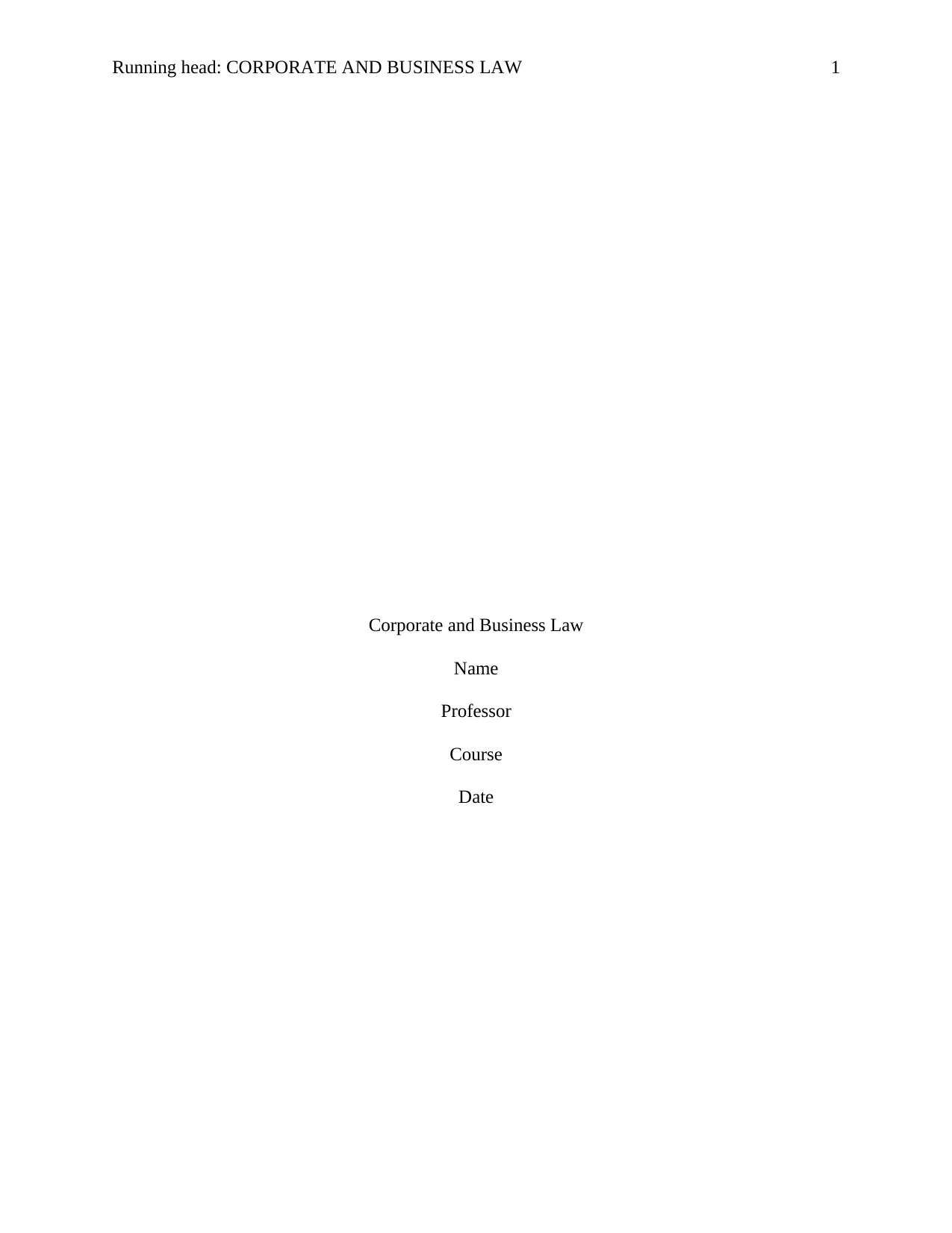
Running head: CORPORATE AND BUSINESS LAW 1
Corporate and Business Law
Name
Professor
Course
Date
Corporate and Business Law
Name
Professor
Course
Date
Paraphrase This Document
Need a fresh take? Get an instant paraphrase of this document with our AI Paraphraser
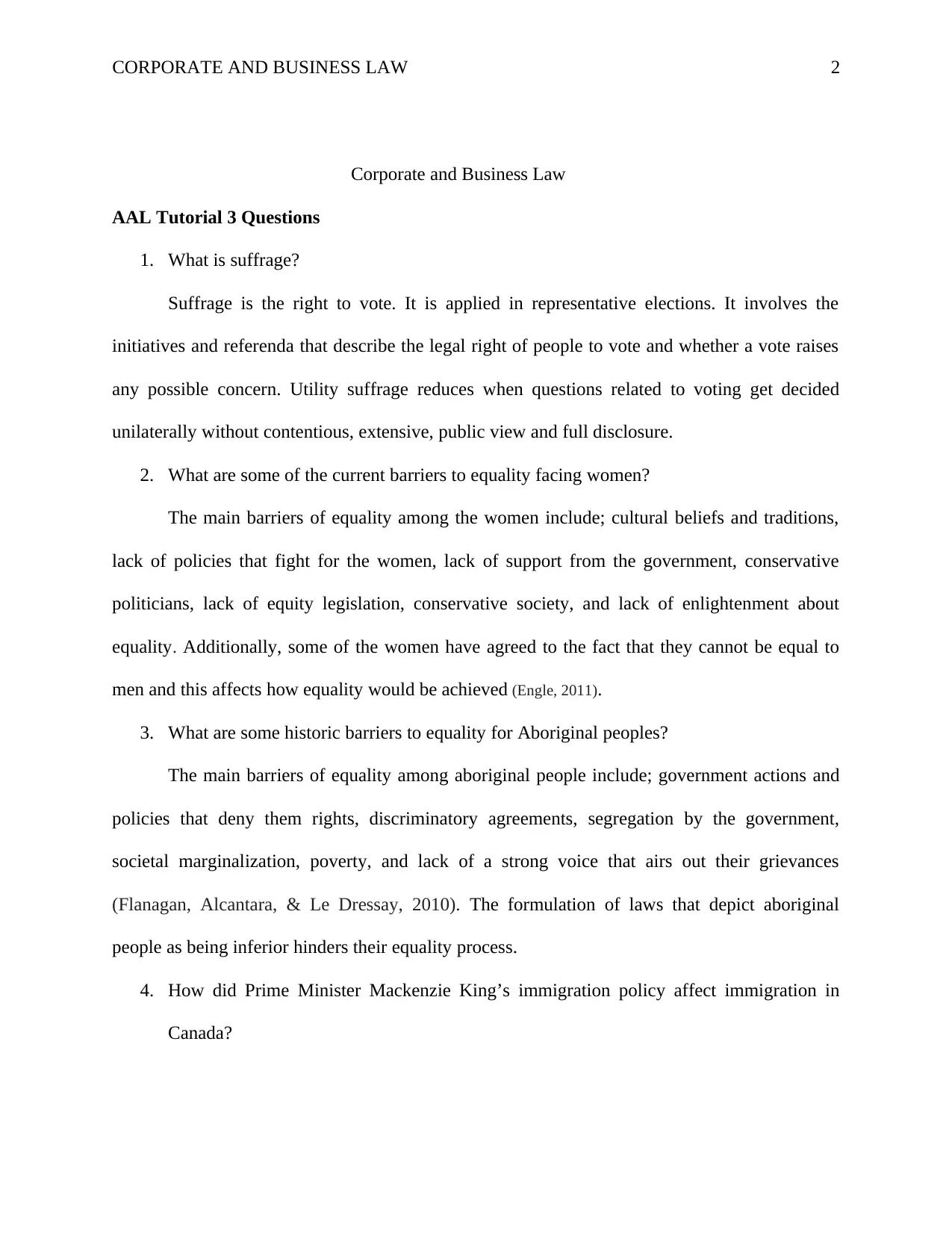
CORPORATE AND BUSINESS LAW 2
Corporate and Business Law
AAL Tutorial 3 Questions
1. What is suffrage?
Suffrage is the right to vote. It is applied in representative elections. It involves the
initiatives and referenda that describe the legal right of people to vote and whether a vote raises
any possible concern. Utility suffrage reduces when questions related to voting get decided
unilaterally without contentious, extensive, public view and full disclosure.
2. What are some of the current barriers to equality facing women?
The main barriers of equality among the women include; cultural beliefs and traditions,
lack of policies that fight for the women, lack of support from the government, conservative
politicians, lack of equity legislation, conservative society, and lack of enlightenment about
equality. Additionally, some of the women have agreed to the fact that they cannot be equal to
men and this affects how equality would be achieved (Engle, 2011).
3. What are some historic barriers to equality for Aboriginal peoples?
The main barriers of equality among aboriginal people include; government actions and
policies that deny them rights, discriminatory agreements, segregation by the government,
societal marginalization, poverty, and lack of a strong voice that airs out their grievances
(Flanagan, Alcantara, & Le Dressay, 2010). The formulation of laws that depict aboriginal
people as being inferior hinders their equality process.
4. How did Prime Minister Mackenzie King’s immigration policy affect immigration in
Canada?
Corporate and Business Law
AAL Tutorial 3 Questions
1. What is suffrage?
Suffrage is the right to vote. It is applied in representative elections. It involves the
initiatives and referenda that describe the legal right of people to vote and whether a vote raises
any possible concern. Utility suffrage reduces when questions related to voting get decided
unilaterally without contentious, extensive, public view and full disclosure.
2. What are some of the current barriers to equality facing women?
The main barriers of equality among the women include; cultural beliefs and traditions,
lack of policies that fight for the women, lack of support from the government, conservative
politicians, lack of equity legislation, conservative society, and lack of enlightenment about
equality. Additionally, some of the women have agreed to the fact that they cannot be equal to
men and this affects how equality would be achieved (Engle, 2011).
3. What are some historic barriers to equality for Aboriginal peoples?
The main barriers of equality among aboriginal people include; government actions and
policies that deny them rights, discriminatory agreements, segregation by the government,
societal marginalization, poverty, and lack of a strong voice that airs out their grievances
(Flanagan, Alcantara, & Le Dressay, 2010). The formulation of laws that depict aboriginal
people as being inferior hinders their equality process.
4. How did Prime Minister Mackenzie King’s immigration policy affect immigration in
Canada?
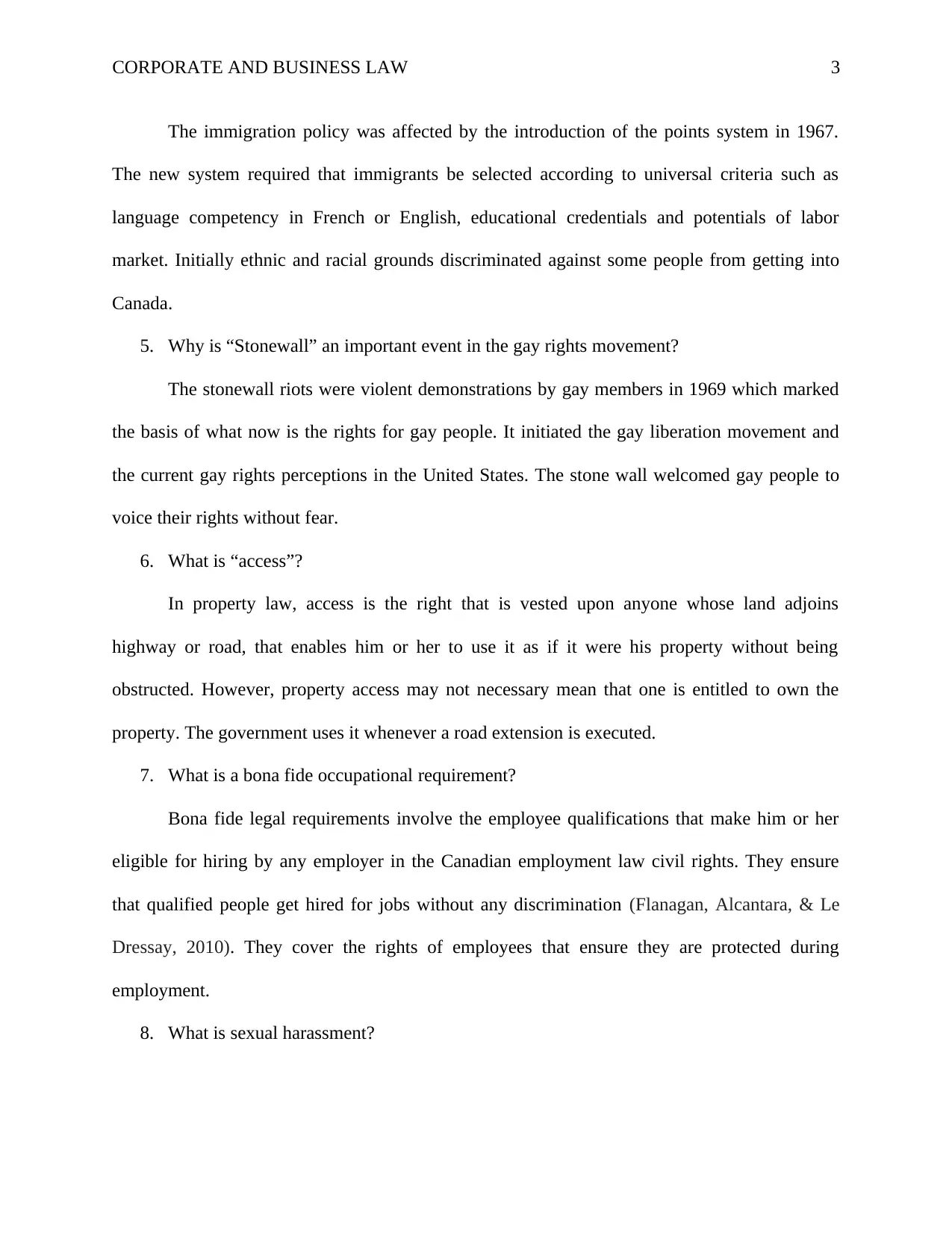
CORPORATE AND BUSINESS LAW 3
The immigration policy was affected by the introduction of the points system in 1967.
The new system required that immigrants be selected according to universal criteria such as
language competency in French or English, educational credentials and potentials of labor
market. Initially ethnic and racial grounds discriminated against some people from getting into
Canada.
5. Why is “Stonewall” an important event in the gay rights movement?
The stonewall riots were violent demonstrations by gay members in 1969 which marked
the basis of what now is the rights for gay people. It initiated the gay liberation movement and
the current gay rights perceptions in the United States. The stone wall welcomed gay people to
voice their rights without fear.
6. What is “access”?
In property law, access is the right that is vested upon anyone whose land adjoins
highway or road, that enables him or her to use it as if it were his property without being
obstructed. However, property access may not necessary mean that one is entitled to own the
property. The government uses it whenever a road extension is executed.
7. What is a bona fide occupational requirement?
Bona fide legal requirements involve the employee qualifications that make him or her
eligible for hiring by any employer in the Canadian employment law civil rights. They ensure
that qualified people get hired for jobs without any discrimination (Flanagan, Alcantara, & Le
Dressay, 2010). They cover the rights of employees that ensure they are protected during
employment.
8. What is sexual harassment?
The immigration policy was affected by the introduction of the points system in 1967.
The new system required that immigrants be selected according to universal criteria such as
language competency in French or English, educational credentials and potentials of labor
market. Initially ethnic and racial grounds discriminated against some people from getting into
Canada.
5. Why is “Stonewall” an important event in the gay rights movement?
The stonewall riots were violent demonstrations by gay members in 1969 which marked
the basis of what now is the rights for gay people. It initiated the gay liberation movement and
the current gay rights perceptions in the United States. The stone wall welcomed gay people to
voice their rights without fear.
6. What is “access”?
In property law, access is the right that is vested upon anyone whose land adjoins
highway or road, that enables him or her to use it as if it were his property without being
obstructed. However, property access may not necessary mean that one is entitled to own the
property. The government uses it whenever a road extension is executed.
7. What is a bona fide occupational requirement?
Bona fide legal requirements involve the employee qualifications that make him or her
eligible for hiring by any employer in the Canadian employment law civil rights. They ensure
that qualified people get hired for jobs without any discrimination (Flanagan, Alcantara, & Le
Dressay, 2010). They cover the rights of employees that ensure they are protected during
employment.
8. What is sexual harassment?
⊘ This is a preview!⊘
Do you want full access?
Subscribe today to unlock all pages.

Trusted by 1+ million students worldwide
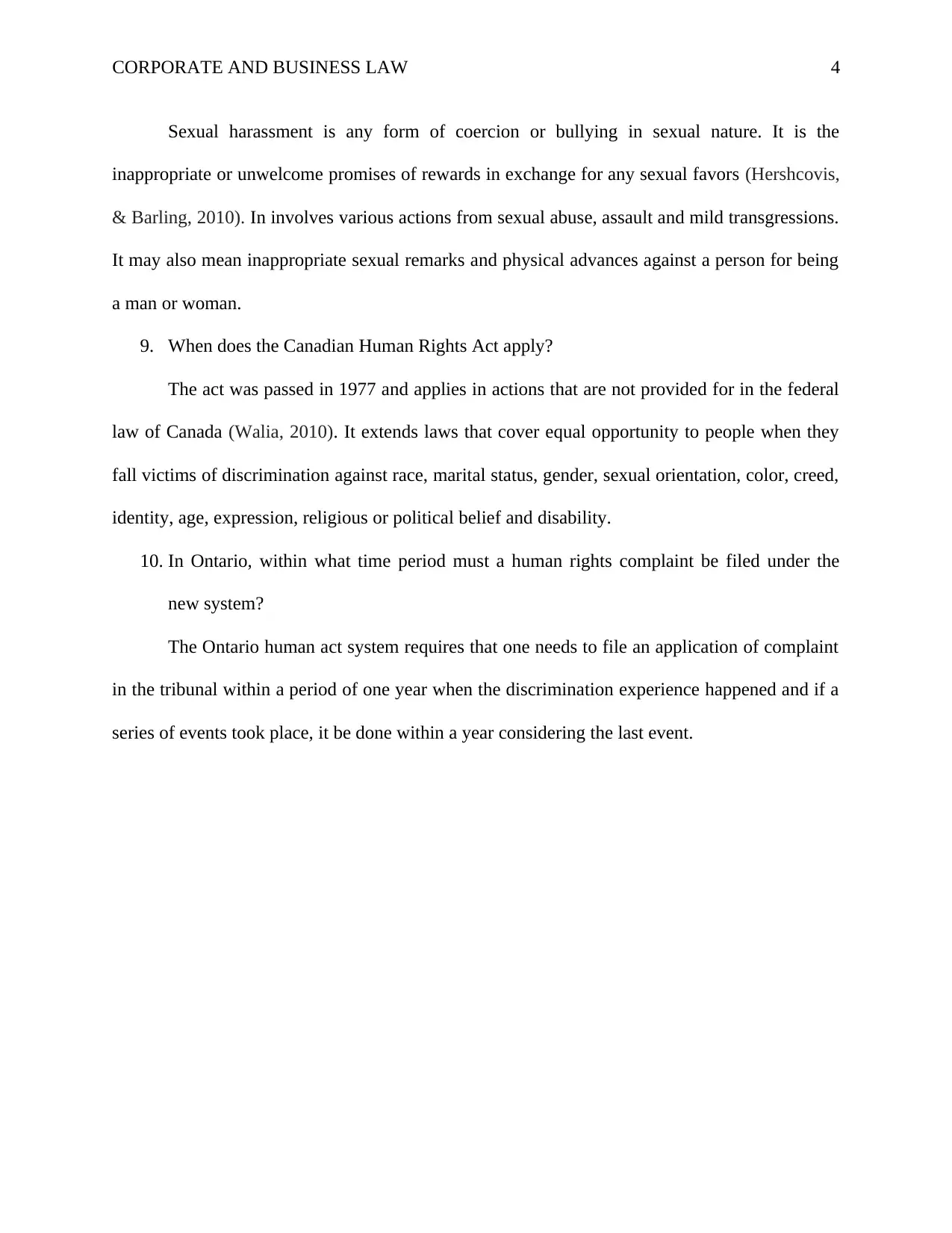
CORPORATE AND BUSINESS LAW 4
Sexual harassment is any form of coercion or bullying in sexual nature. It is the
inappropriate or unwelcome promises of rewards in exchange for any sexual favors (Hershcovis,
& Barling, 2010). In involves various actions from sexual abuse, assault and mild transgressions.
It may also mean inappropriate sexual remarks and physical advances against a person for being
a man or woman.
9. When does the Canadian Human Rights Act apply?
The act was passed in 1977 and applies in actions that are not provided for in the federal
law of Canada (Walia, 2010). It extends laws that cover equal opportunity to people when they
fall victims of discrimination against race, marital status, gender, sexual orientation, color, creed,
identity, age, expression, religious or political belief and disability.
10. In Ontario, within what time period must a human rights complaint be filed under the
new system?
The Ontario human act system requires that one needs to file an application of complaint
in the tribunal within a period of one year when the discrimination experience happened and if a
series of events took place, it be done within a year considering the last event.
Sexual harassment is any form of coercion or bullying in sexual nature. It is the
inappropriate or unwelcome promises of rewards in exchange for any sexual favors (Hershcovis,
& Barling, 2010). In involves various actions from sexual abuse, assault and mild transgressions.
It may also mean inappropriate sexual remarks and physical advances against a person for being
a man or woman.
9. When does the Canadian Human Rights Act apply?
The act was passed in 1977 and applies in actions that are not provided for in the federal
law of Canada (Walia, 2010). It extends laws that cover equal opportunity to people when they
fall victims of discrimination against race, marital status, gender, sexual orientation, color, creed,
identity, age, expression, religious or political belief and disability.
10. In Ontario, within what time period must a human rights complaint be filed under the
new system?
The Ontario human act system requires that one needs to file an application of complaint
in the tribunal within a period of one year when the discrimination experience happened and if a
series of events took place, it be done within a year considering the last event.
Paraphrase This Document
Need a fresh take? Get an instant paraphrase of this document with our AI Paraphraser
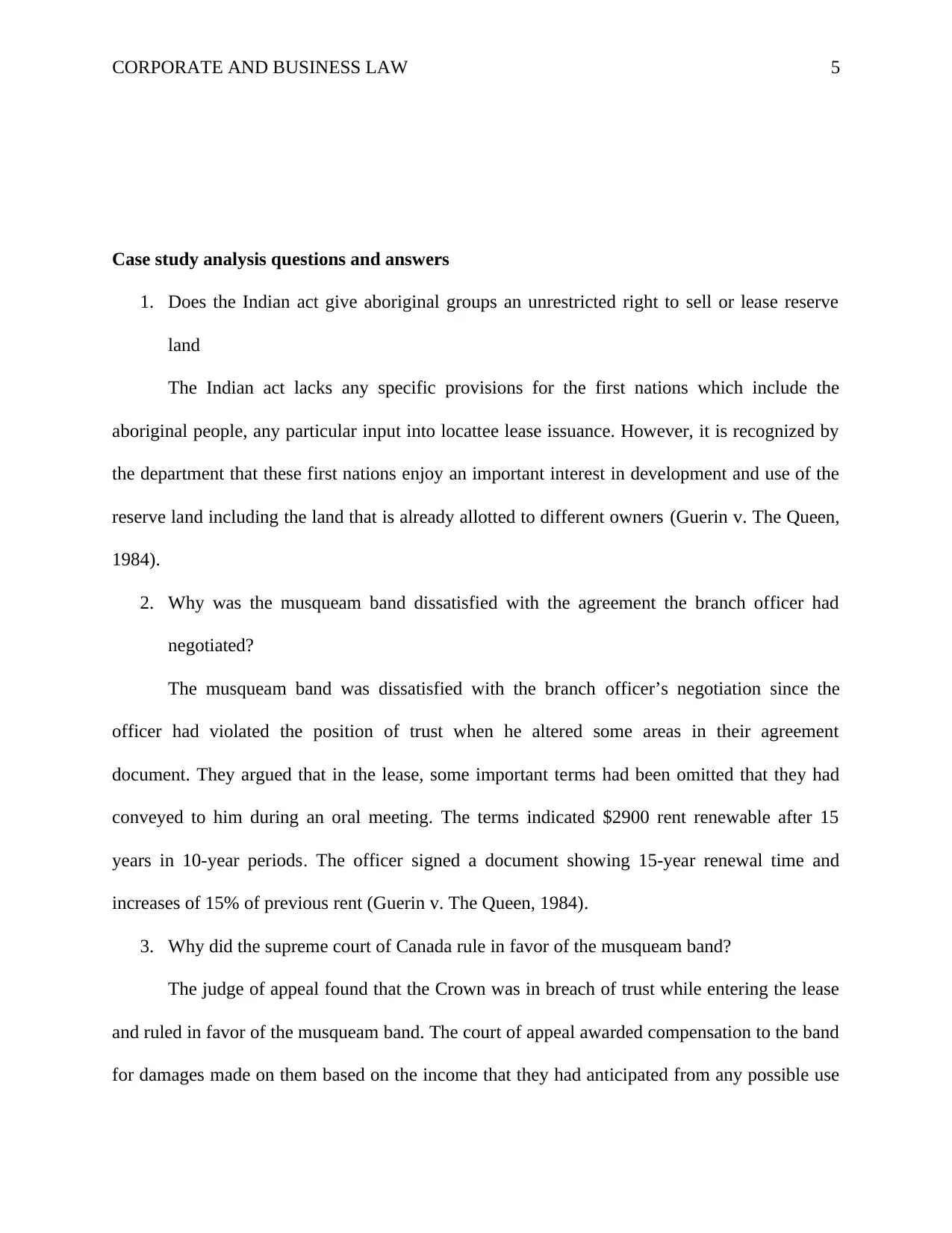
CORPORATE AND BUSINESS LAW 5
Case study analysis questions and answers
1. Does the Indian act give aboriginal groups an unrestricted right to sell or lease reserve
land
The Indian act lacks any specific provisions for the first nations which include the
aboriginal people, any particular input into locattee lease issuance. However, it is recognized by
the department that these first nations enjoy an important interest in development and use of the
reserve land including the land that is already allotted to different owners (Guerin v. The Queen,
1984).
2. Why was the musqueam band dissatisfied with the agreement the branch officer had
negotiated?
The musqueam band was dissatisfied with the branch officer’s negotiation since the
officer had violated the position of trust when he altered some areas in their agreement
document. They argued that in the lease, some important terms had been omitted that they had
conveyed to him during an oral meeting. The terms indicated $2900 rent renewable after 15
years in 10-year periods. The officer signed a document showing 15-year renewal time and
increases of 15% of previous rent (Guerin v. The Queen, 1984).
3. Why did the supreme court of Canada rule in favor of the musqueam band?
The judge of appeal found that the Crown was in breach of trust while entering the lease
and ruled in favor of the musqueam band. The court of appeal awarded compensation to the band
for damages made on them based on the income that they had anticipated from any possible use
Case study analysis questions and answers
1. Does the Indian act give aboriginal groups an unrestricted right to sell or lease reserve
land
The Indian act lacks any specific provisions for the first nations which include the
aboriginal people, any particular input into locattee lease issuance. However, it is recognized by
the department that these first nations enjoy an important interest in development and use of the
reserve land including the land that is already allotted to different owners (Guerin v. The Queen,
1984).
2. Why was the musqueam band dissatisfied with the agreement the branch officer had
negotiated?
The musqueam band was dissatisfied with the branch officer’s negotiation since the
officer had violated the position of trust when he altered some areas in their agreement
document. They argued that in the lease, some important terms had been omitted that they had
conveyed to him during an oral meeting. The terms indicated $2900 rent renewable after 15
years in 10-year periods. The officer signed a document showing 15-year renewal time and
increases of 15% of previous rent (Guerin v. The Queen, 1984).
3. Why did the supreme court of Canada rule in favor of the musqueam band?
The judge of appeal found that the Crown was in breach of trust while entering the lease
and ruled in favor of the musqueam band. The court of appeal awarded compensation to the band
for damages made on them based on the income that they had anticipated from any possible use
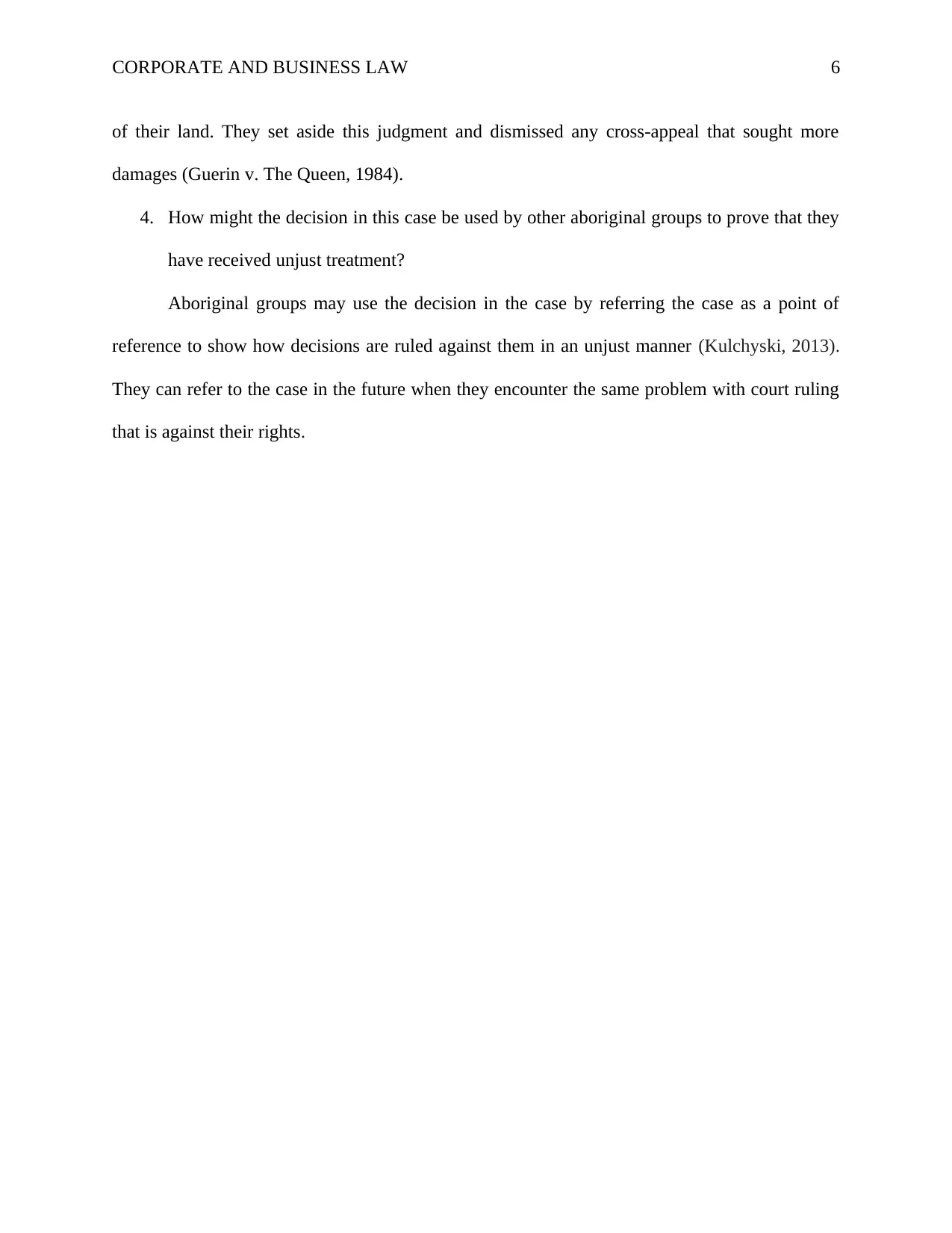
CORPORATE AND BUSINESS LAW 6
of their land. They set aside this judgment and dismissed any cross-appeal that sought more
damages (Guerin v. The Queen, 1984).
4. How might the decision in this case be used by other aboriginal groups to prove that they
have received unjust treatment?
Aboriginal groups may use the decision in the case by referring the case as a point of
reference to show how decisions are ruled against them in an unjust manner (Kulchyski, 2013).
They can refer to the case in the future when they encounter the same problem with court ruling
that is against their rights.
of their land. They set aside this judgment and dismissed any cross-appeal that sought more
damages (Guerin v. The Queen, 1984).
4. How might the decision in this case be used by other aboriginal groups to prove that they
have received unjust treatment?
Aboriginal groups may use the decision in the case by referring the case as a point of
reference to show how decisions are ruled against them in an unjust manner (Kulchyski, 2013).
They can refer to the case in the future when they encounter the same problem with court ruling
that is against their rights.
⊘ This is a preview!⊘
Do you want full access?
Subscribe today to unlock all pages.

Trusted by 1+ million students worldwide
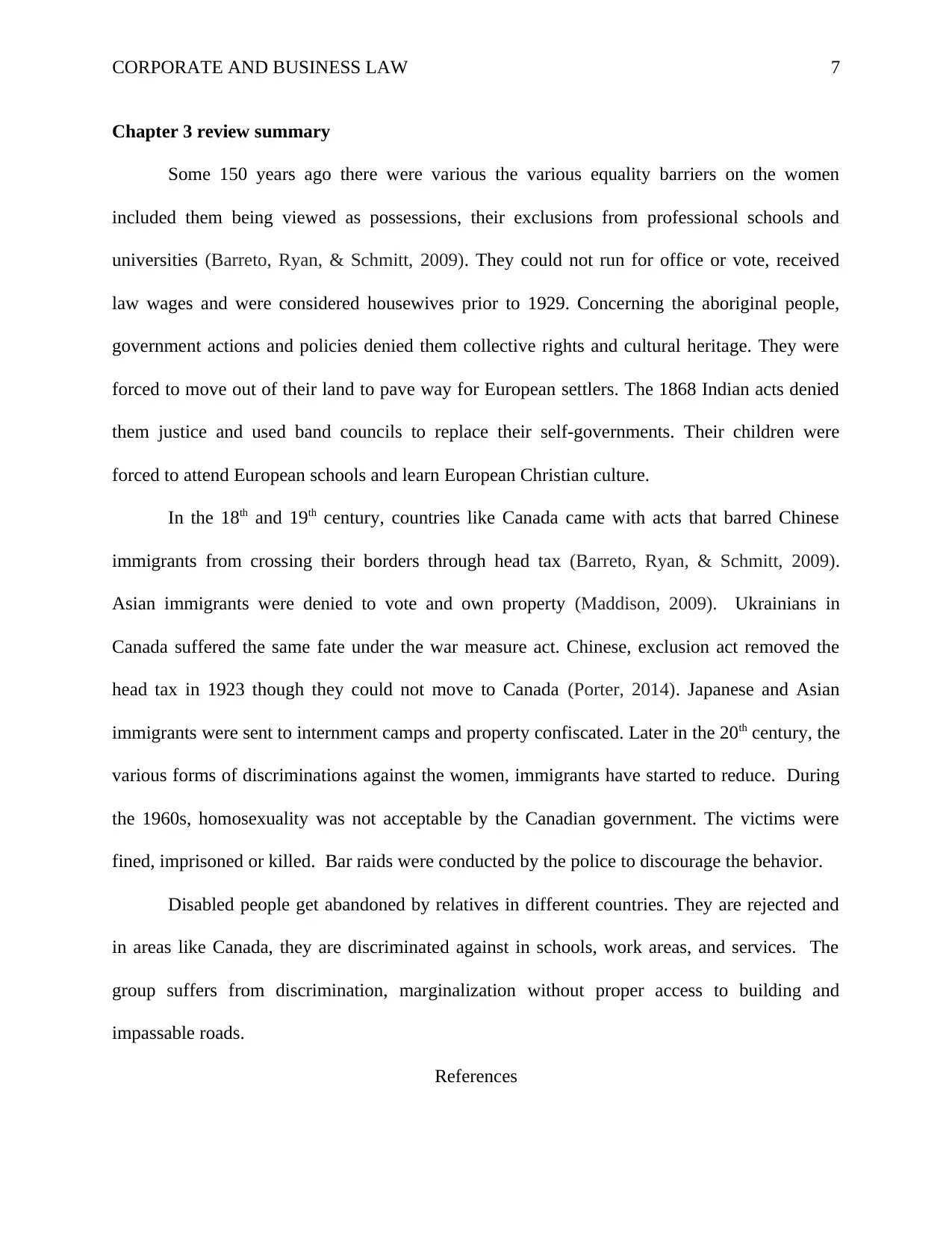
CORPORATE AND BUSINESS LAW 7
Chapter 3 review summary
Some 150 years ago there were various the various equality barriers on the women
included them being viewed as possessions, their exclusions from professional schools and
universities (Barreto, Ryan, & Schmitt, 2009). They could not run for office or vote, received
law wages and were considered housewives prior to 1929. Concerning the aboriginal people,
government actions and policies denied them collective rights and cultural heritage. They were
forced to move out of their land to pave way for European settlers. The 1868 Indian acts denied
them justice and used band councils to replace their self-governments. Their children were
forced to attend European schools and learn European Christian culture.
In the 18th and 19th century, countries like Canada came with acts that barred Chinese
immigrants from crossing their borders through head tax (Barreto, Ryan, & Schmitt, 2009).
Asian immigrants were denied to vote and own property (Maddison, 2009). Ukrainians in
Canada suffered the same fate under the war measure act. Chinese, exclusion act removed the
head tax in 1923 though they could not move to Canada (Porter, 2014). Japanese and Asian
immigrants were sent to internment camps and property confiscated. Later in the 20th century, the
various forms of discriminations against the women, immigrants have started to reduce. During
the 1960s, homosexuality was not acceptable by the Canadian government. The victims were
fined, imprisoned or killed. Bar raids were conducted by the police to discourage the behavior.
Disabled people get abandoned by relatives in different countries. They are rejected and
in areas like Canada, they are discriminated against in schools, work areas, and services. The
group suffers from discrimination, marginalization without proper access to building and
impassable roads.
References
Chapter 3 review summary
Some 150 years ago there were various the various equality barriers on the women
included them being viewed as possessions, their exclusions from professional schools and
universities (Barreto, Ryan, & Schmitt, 2009). They could not run for office or vote, received
law wages and were considered housewives prior to 1929. Concerning the aboriginal people,
government actions and policies denied them collective rights and cultural heritage. They were
forced to move out of their land to pave way for European settlers. The 1868 Indian acts denied
them justice and used band councils to replace their self-governments. Their children were
forced to attend European schools and learn European Christian culture.
In the 18th and 19th century, countries like Canada came with acts that barred Chinese
immigrants from crossing their borders through head tax (Barreto, Ryan, & Schmitt, 2009).
Asian immigrants were denied to vote and own property (Maddison, 2009). Ukrainians in
Canada suffered the same fate under the war measure act. Chinese, exclusion act removed the
head tax in 1923 though they could not move to Canada (Porter, 2014). Japanese and Asian
immigrants were sent to internment camps and property confiscated. Later in the 20th century, the
various forms of discriminations against the women, immigrants have started to reduce. During
the 1960s, homosexuality was not acceptable by the Canadian government. The victims were
fined, imprisoned or killed. Bar raids were conducted by the police to discourage the behavior.
Disabled people get abandoned by relatives in different countries. They are rejected and
in areas like Canada, they are discriminated against in schools, work areas, and services. The
group suffers from discrimination, marginalization without proper access to building and
impassable roads.
References
Paraphrase This Document
Need a fresh take? Get an instant paraphrase of this document with our AI Paraphraser
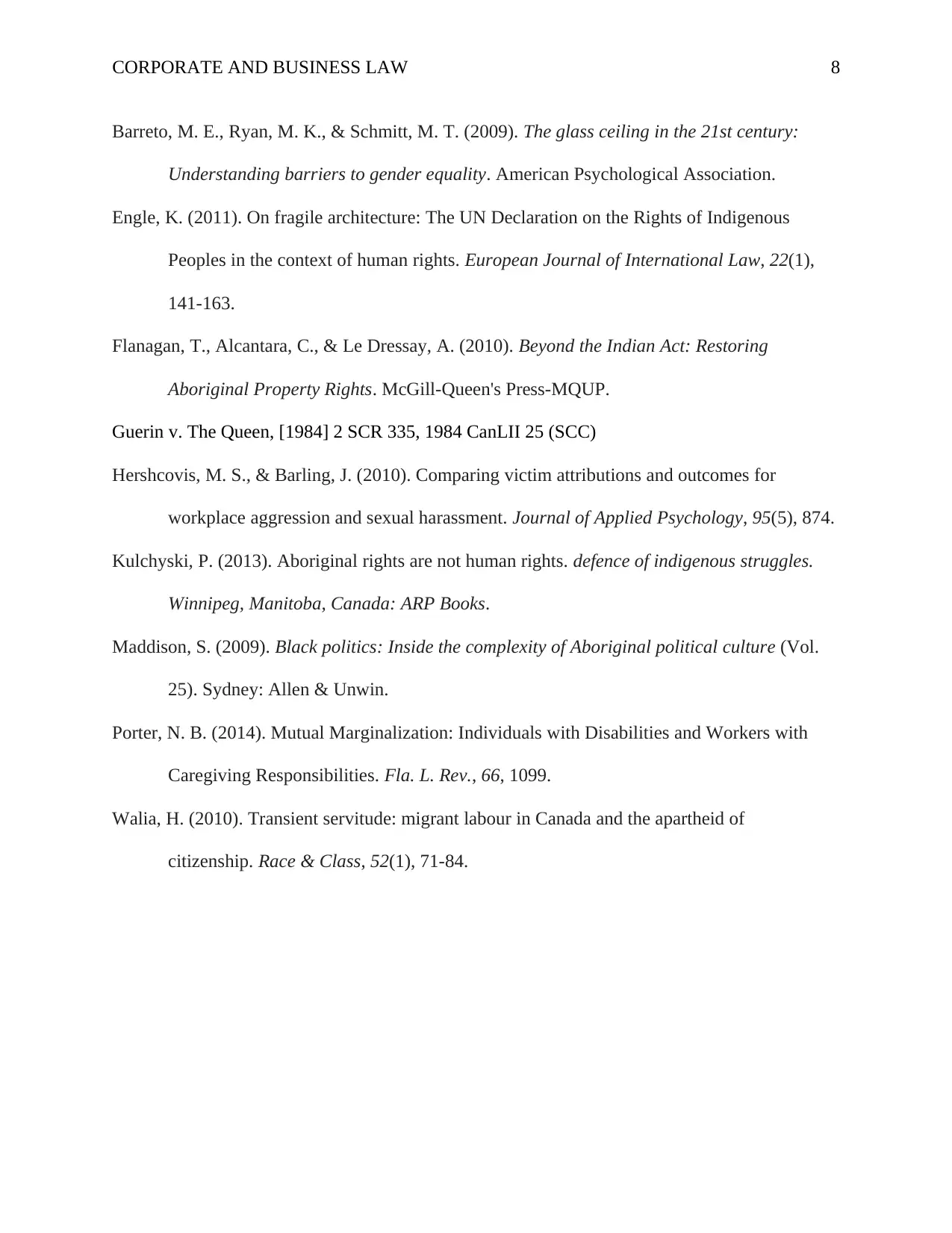
CORPORATE AND BUSINESS LAW 8
Barreto, M. E., Ryan, M. K., & Schmitt, M. T. (2009). The glass ceiling in the 21st century:
Understanding barriers to gender equality. American Psychological Association.
Engle, K. (2011). On fragile architecture: The UN Declaration on the Rights of Indigenous
Peoples in the context of human rights. European Journal of International Law, 22(1),
141-163.
Flanagan, T., Alcantara, C., & Le Dressay, A. (2010). Beyond the Indian Act: Restoring
Aboriginal Property Rights. McGill-Queen's Press-MQUP.
Guerin v. The Queen, [1984] 2 SCR 335, 1984 CanLII 25 (SCC)
Hershcovis, M. S., & Barling, J. (2010). Comparing victim attributions and outcomes for
workplace aggression and sexual harassment. Journal of Applied Psychology, 95(5), 874.
Kulchyski, P. (2013). Aboriginal rights are not human rights. defence of indigenous struggles.
Winnipeg, Manitoba, Canada: ARP Books.
Maddison, S. (2009). Black politics: Inside the complexity of Aboriginal political culture (Vol.
25). Sydney: Allen & Unwin.
Porter, N. B. (2014). Mutual Marginalization: Individuals with Disabilities and Workers with
Caregiving Responsibilities. Fla. L. Rev., 66, 1099.
Walia, H. (2010). Transient servitude: migrant labour in Canada and the apartheid of
citizenship. Race & Class, 52(1), 71-84.
Barreto, M. E., Ryan, M. K., & Schmitt, M. T. (2009). The glass ceiling in the 21st century:
Understanding barriers to gender equality. American Psychological Association.
Engle, K. (2011). On fragile architecture: The UN Declaration on the Rights of Indigenous
Peoples in the context of human rights. European Journal of International Law, 22(1),
141-163.
Flanagan, T., Alcantara, C., & Le Dressay, A. (2010). Beyond the Indian Act: Restoring
Aboriginal Property Rights. McGill-Queen's Press-MQUP.
Guerin v. The Queen, [1984] 2 SCR 335, 1984 CanLII 25 (SCC)
Hershcovis, M. S., & Barling, J. (2010). Comparing victim attributions and outcomes for
workplace aggression and sexual harassment. Journal of Applied Psychology, 95(5), 874.
Kulchyski, P. (2013). Aboriginal rights are not human rights. defence of indigenous struggles.
Winnipeg, Manitoba, Canada: ARP Books.
Maddison, S. (2009). Black politics: Inside the complexity of Aboriginal political culture (Vol.
25). Sydney: Allen & Unwin.
Porter, N. B. (2014). Mutual Marginalization: Individuals with Disabilities and Workers with
Caregiving Responsibilities. Fla. L. Rev., 66, 1099.
Walia, H. (2010). Transient servitude: migrant labour in Canada and the apartheid of
citizenship. Race & Class, 52(1), 71-84.
1 out of 8
Your All-in-One AI-Powered Toolkit for Academic Success.
+13062052269
info@desklib.com
Available 24*7 on WhatsApp / Email
![[object Object]](/_next/static/media/star-bottom.7253800d.svg)
Unlock your academic potential
Copyright © 2020–2025 A2Z Services. All Rights Reserved. Developed and managed by ZUCOL.